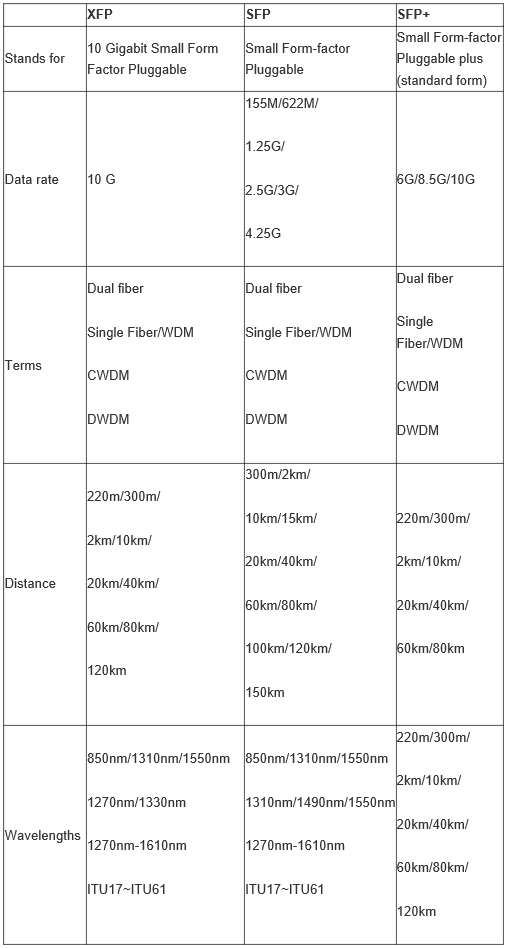- Related articles
- Optical Transceivers for Cisco SG250-10P-K9-UK Switch
- Optical Transceivers for Cisco WS-C3850-48XS-S Switch
- Optical Transceivers for Cisco WS-C3560C-12PC-S Switch
- What Is GYTS Fiber Optic Cable?
- Optical Transceivers for Cisco ME-3600X-24TS-M= Switch
- What Is Network Card PCI Express x1?
- All Cisco DWDM-XFP-35.04's information (List price, Specs, Datasheet PDF, Compatibility ma
- Applicable to 10GBASE-LW Standard Optical Transceiver Models
- All Cisco ONS-SI-GE-ZX's information (List price, Specs, Datasheet PDF, Compatibility matr
- EOL Cisco Switch WS-C2960S-48FPS-L Replaced with WS-C2960X-48FPS-L

What’s the key difference among the Cisco XFP, SFP and SFP+? SFP, SFP+ and XFP, all refer to a type of transceiver that is plugged into a special port on a switch or to some network device. These transceivers are used in the field of telecommunication and data communication.
XFP (10 Gigabit Small Form Factor Pluggable) is a standard for the transceivers. This type of transceiver is not dependent on the protocol. Generally, it operates at optical wavelenghts corresponding to 850nm, 1310nm or 1550nm. The modules belonging to the XFP are hot swappable which means that the function of replacing the computer system components can be performed without shutting down the system. The specifications of XPF were developed by the XFP Multi Source Agreement Group. XFP complies with the agreement known as XFP MSA agreement.
“SFP” stands for “Small Form-factor Pluggable.” SFP protocol specifications are based on IEEE802.3, SFF-8472. It is most often used for Fast Ethernet of Gigabit Ethernet applications. They are capable of supporting speeds upto 4.25 Gbps. It interfaces a network device motherboard (for a switch, router, media converter or similar device) to a fiber optic or copper networking cable. It is specified by the SFP transceiver multi-source agreement.
SFP+ can be referred to as an expansion of the SFP standard. SFP+ modules are smaller than XFP. It has the capability to support speeds of 10 Gbps or even higher over fiber. The SFP+ product family includes cages, connectors, and copper cable assemblies. It is also similar to the performance requirements of SFF-8431 and also supports 8G Fiber Channel and 10G Ethernet applications. SFP+ comes with various advantages. It is a more compact factor package than compared to that of XFP. The cost of SFP+ is also less than that to the XFP, X2 and XENPAK. And it can connect with the same type of XFP, X2 and XENPAK directly.
What’s the connection between XFP and SFP+? Generally speaking, both of them are 10G fiber optical modules and can connect with other type of 10G modules. The size of SFP+ is smaller than XFP, thus it moves some functions to motherboard, including signal modulation function, MAC, CDR and EDC. XFP is based on the standard of XFP MSA. SFP+ is compliance with the protocol of IEEE802.3ae, SFF-8431, SFF-8432. SFP+ is the mainstream design.
What are the Cisco XFP, SFP and SFP+ in general?
XFP-the first of the small form factor 10GbE optics. Presents LC connectors
SFP-also called mini-GBIC, is upgraded version of GBIC transceiver
SFP+-a 10GbE optics using the same physical form factor as a gigabit SFP. Because of this, many of the small SFP+ based 10GbE switches use 1G/10G ports, giving an added degree of flexibility. Presents LC connectors
XFP, SFP and SFP+ Comparison

The differences between SFP and SFP+
1. SFP doesn't support 10G transmission data rate that means they can't be used in the same network.
2. From the price, SFP+ is more expensive than SFP+
3. SFP is based on IEEE802.3 and SFF-8472 while SFP+ is based on SFF-8431.
Ethernet Application
| SFP (1Gbps) | SFP+ (10Gbps) |
1000BASE-SX SFP 850nm 550m 1000BASE-LX/LH SFP 1310nm 20km 1000BASE-EX SFP 1310nm 40km 1000BASE-ZX SFP 1550nm 80km | 10GBASE-SR SFP+ 850nm 300m 10GBASE-LRM SFP+ 1310nm 220m 10GBASE-LR SFP+ 1310nm 10km 10GBASE-ER SFP+ 1550nm 40km 10GBASE-ZR SFP+ 1550nm 100km |
Fiber Channel Application
| SFP (2G, 4G) | SFP+ (8G) |
2.125Gbps: 2G Fibre Channel SFP 1310nm 2km/15km/20km/40km 2G Fibre Channel SFP 1510nm 80km 4.25Gbps: 4G Fibre Channel SFP 850nm 150m 4G Fibre Channel SFP 1310nm 5km/10km/15km/20km | 8.5Gbps: 8G Fibre Channel SFP+ 850nm 150m 8G Fibre Channel SFP+ 1310mn 10km/20km/40km 8G Fibre Channel SFP+ 1510nm 80km |
SONET/SDH Application
| SFP (155Mbps, 622Mbps, 2.5Gbps) | SFP+ (10G) |
155Mbps: OC-3/STM-1 1310nm 2km/15km/40km OC-3/STM-1 1510nm 80km 622Mbps: OC-12/STM-4 1310nm 500m/2km/15km/40km OC-12/STM-4 1510nm 80km 2.5Gbps: OC-48/STM-16 1310nm 2km/15km/40km OC-48/STM-16 1510nm 80km | OC-192/STM-64 850nm 300m OC-192/STM-64 1310nm 2km/10km/20km/40km OC-192/STM-64 1510nm 80km |
The Connection between XFP and SFP+
1. Both of them are 10G fiber optical modules and can connect with other type of 10G modules.
2. The size of SFP+ is smaller than XFP, thus it moves some functions to motherboard, including signal modulation function, MAC, CDR and EDC.
3. XFP is based on the standard of XFP MSA
4. SFP+ is compliance with the protocol of IEEE802.3ae, SFF-8431, SFF-8432.
5. SFP+ is the mainstream design.
The Advantages of SFP+ Module
1. SFP+ has a more compact form factor package than X2 and XFP.
2. It can connect with the same type of XFP, X2 and XENPAK directly.
3. The cost of SFP+ is lower than XFP, X2 and XENPAK.





































































